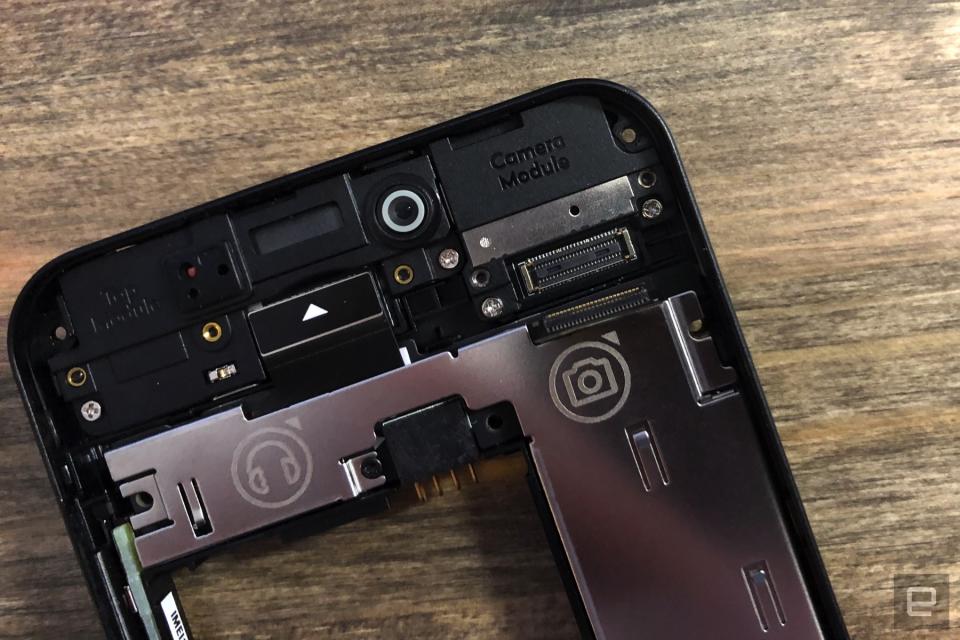Engadget has been testing and reviewing consumer tech since 2004. Our stories may include affiliate links; if you buy something through a link, we may earn a commission. Read more about how we evaluate products.
Even an idiot can repair a Fairphone
Installing a new camera module is easy, once you know how.
I’m secretly envious of people who can make stuff, from knitters and cosplayers to hobbyists with soldering irons and Arduino boards. As much as I’d love to be a member of their gang, however, I lack the patience, aptitude and demeanor to make anything more than a mess. Electronics and woodworking classes at school were torture, and my ambition far exceeded my actual abilities.
At school, as a lunch-hour project, I tried to build fancy chess sets with ogee edging and a built-in drawer to store the pieces. I spent a whole year on it, and it managed to collapse into pieces while I was carrying it home at the end of the summer term. Experiences like this are why I rarely feel confident enough to tear open a gadget to make a repair.
Despite that, I was interested in Fairphone -- the Dutch social enterprise that makes a more ethical smartphone -- and its claim that its phones are easy enough even for rank amateurs to fix. I held off doing this before the new handset was announced, since I didn’t want to break it before previewing the device. My loaner unit was soon headed back to Fairphone headquarters, so it felt like a good time to mess with it — not much risk of feeling guilty afterward.
The company loaned me both the FairPhone 3 and the 3+. I was told that it would be easy to swap modules between the two. It made sense to try and pull out the fancier camera module from the 3+ and retrofit it into the 3. This is the upgrade that most folks could, and would, attempt, since you can buy the camera module and install into the older phone. And if it’s easy enough to do, then perhaps it’ll convince wary buyers that owning a modular device is worth the effort.
So how did it go? Well, I had a bundle of documents from Fairphone, but even the company advises everyone to read the iFixit guides to coach you through the process. Fairphone says that you can access every part of the phone once you remove the 13 screws that connect the display module to the body. Accessing them is easy enough; you just have to pull the back cover off, flip out the battery and get to work with your screwdriver.

This did, however, take me the better part of an hour, if only because I was nervous and the screws were tightly held in their recesses. In fact, I needed to grab my screwdriver and pliers from my glasses repair kit to pry them out. The most stressful moment came when I was trying to push the screen away from the body, initially very gently and then with increasing force. All I could think about at the time was how much I’d owe Fairphone if I smashed the glass, and how badly I might ruin my desk.
Then, mercifully, the two modules parted and I was on top of the world. I am MacGuyver! Once I finished congratulating myself, it turned out that everything else was simple. The phone’s camera module was connected by two screws and a ribbon cable, which flipped out easily. Disassembling the Fairphone 3 to install the 3+ camera module took less time, now I knew what to expect. It went from an hour to closer to 15 minutes.
When it was time to put everything back together, I was blown away by how easy it all was. This felt more like building a piece of IKEA furniture than swapping around complicated electronics. I didn’t even have a screw leftover or a lingering sense of failure by the end of it.
Although the European Union is looking at imposing minimum standards of repairability on electronics, this whole process reminded me of what’s lost when major phone manufacturers began valuing waterproofing and thinness over repairability.
My own three-year-old iPhone 8 Plus is in a bad way or at least, its battery is, which now requires a full recharge at lunchtime to make it through the day. I’ve held off on upgrading until now, just in case the iPhone 12 is amazing enough to warrant a purchase.
Otherwise, I’ll trudge down to my nearest repair place to get the battery swapped out for £50 ($49) and keep it going another two years. It’s just a shame that I can’t just do this myself. I’ve got the knack for it now.

